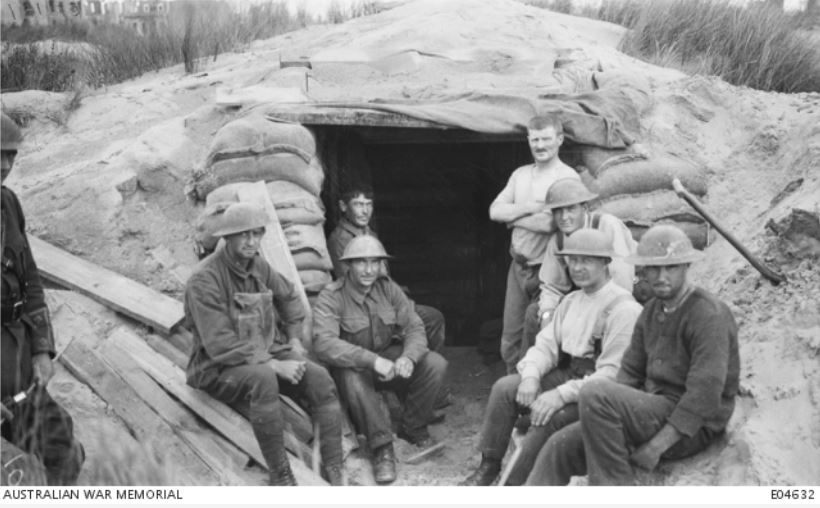2nd Tunneling Company
From Our Contribution
 Shoulder patch | |
 Men of the 2nd Tunnelling Company are seen at the entrance to a system of dugouts. AWM E04632 | |
Brief History
On 10 September 1915, the British government sent an appeal to Canada, South Africa, Australia and New Zealand to raise tunnelling companies in the Dominions of the British Empire.
The Royal Australian Engineers formed four mining units – initially grouped into the Australian Mining Corps – for the British Expeditionary Force. It is known that the manning of that unit specifically included a proportion of members from the mining industry and allowed enlistment up to the age of 50 to capture the experienced men the Corps would need to fulfil its role. About 38% of the men had been employed within the mining industry.
The intention was to employ this unit, which was at that time about 1,000 strong, with the ANZAC at Gallipoli, but instead it was moved to France in May 1916, where it also appeared as the "Australian Mining Battalion". Soon after arriving in western Europe in May 1916, the battalion was split into three tunnelling and one repairs company, and the corps headquarters dissolved.
After a fairly short training period with British and Canadian Tunnelling Companies already in France, the Australian Companies were allotted to different Armies and assigned separate areas of responsibility. Their tasks were allocated by the General Officer Commanding the British Expeditionary Force through the Controller of Mines. Primary tasks of the Tunnelling Companies were the construction of tunnels and mines for offensive action against the enemy, detection and interruption of the enemy’s counter-mining efforts, and the construction of underground dugouts to accommodate large groups of men, in many cases whole battalions of 1,000 men including Battalion Headquarters.
Vimy - the 2nd Australian Tunnelling Company relieved the 172nd Tunnelling Company in May 1916 in the Neuville-Saint-Vaast/Vimy area. In this sector was the German "Labyrinth" stronghold, located between Arras and Vimy and not far from Notre Dame de Lorette.
Ypres Salient - In January 1917, the company relieved the 1st Canadian Tunnelling Company at The Bluff in the Ypres Salient. They moved to Nieuport in the same month, to construct subways as part of Operation Hush. On 10 May 1917, the company took over the 1st Canadian Tunnelling Company's workings at the Lock Hospital position. The Lock Hospital position was located at Lock 6 on the Ypres-Comines canal, and the tunnel extended from there to a point beneath the British lines some 400 metres away.
Messines 1916/17 - The Battle of Messines was a prelude to the much larger Third Battle of Ypres (31 July – 10 November 1917). The underground building activities of the Royal Engineer units consisted of a series of deep mines dug by the British Canadian, and the 1st Australian Tunnelling companies. They were to be fired at the start of the Battle of Messines (7–14 June 1917), while other units including the 2nd Australian Tunnelling company built underground shelters in the Second Army area. The mines at Messines were detonated on 7 June 1917, creating 19 large craters.
Belgian coast - In the coastal sector at Nieuport/Nieuwpoort, the 2nd Australian Tunnelling Company was involved in repelling a German spoiling attack – Operation Strandfest – in July 1917. sector.
In April 1918, troops of the 2nd Australian Tunnelling Company fought a large fire in Peronne.
Unit Personnel
- Cecil James Clark 17 May 1917 - 15 May 1919
- William Thomas Driver 30 Mar 1917 - 25 Apr 1919
Individual Honours
- 1 Distinguished Service Order
- 1 Member of the Order of the British Empire
- 11 Military Crosses
- 11 Distinguished Conduct Medals
- 19 Military Medals
- 15 Mentioned in Despatches
- 9 Foreign Awards
Notes
Content for the history and honours sections has come from a combination of Wikipedia and the Australian War Memorial webpages.
For further detail on the Tunnelling units during ww1, see:
- Crumos and Camouflets - Australian Tunnelling Companies on the Western Front by D Findlayson